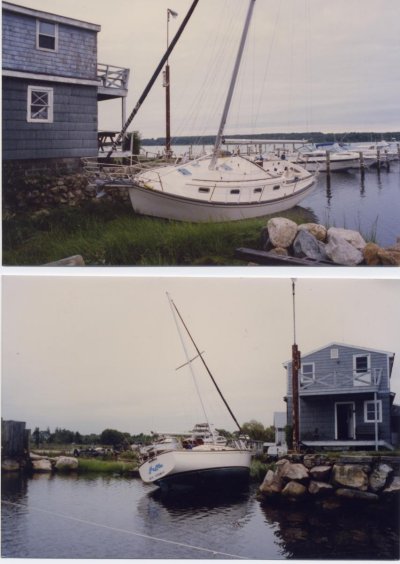Hurricanes George (1998), Irene (1999), etc. happened on us when we were living near FLL and working in Miami... but we were sort of in between boats then (original boat still in MD during George, still shopping during Irene, etc.) so didn't really have to do much boat prep. Learned all about hurricane shutters, though...
Hurricane Isabel, 2003: Our home dock was very wide -- we essentially docked our previous boat "sideways" across three slips meant for ~24' boats -- so we tied the boat in the center with ~12 or so very long lines, walked away, hoped for the best. That kept the boat from getting beat up on piles, and worked well for the ~8' storm surge. Several of the neighbor boats in slips but on lifts... floated off... didn't land nicely...
Hurricane Irene, 2011: Current boat, different home marina... we moved from our own marina to one with new floating docks. Tied up with about 16 lines, walked away (had to evacuate that area), hoped for the best, worked out OK.
TS Sandy, 2012: Current boat, prep during the period when Sandy was still a Hurricane and still aimed at us... we moved to a more sheltered marina with new floating docks. Ditto ~16 lines, ended up staying on board (no evacuation order there, Sandy downgraded to TS, and the track changed to further away from here), worked out OK.
For Isabel and Irene, we stripped the boat -- canvas down, etc. -- but for Sandy we didn't have to do all that.
-Chris
Your experiences are typical of those I've heard from others in Fort Lauderdale. Maybe we'll suddenly have the 500 year storm as opposed to the 100 year storm, but barring that a lot of the fears of both boat owners and home owners are based on conditions that don't seem to happen here. There are two aspects of hurricanes to prepare for.
The first is surge and the docks being constructed today are for the most part built to handle surge greater than Fort Lauderdale has seen. They are well secured floating docks with pilings taller than the greatest surges to hit here. Our home appears to be dangerously close to the water, but per the current flood maps and the 100 year histories, there hasn't been a surge that would reach it.
The second part is wind. There it seems to come down to how well the dock and boat in the water or the blocks and boat on land are secured. I would say that the best hurricane prepared shipyards have superior tie downs and blocks, but the majority of yards just lifting a boat out of the water and blocking it, do not. Location is also important as it seems the winds are typically stronger at the higher elevations of land. As to houses, most of those built on the coast here in recent years have been built to stand up to greater winds. They have windows designed for it or storm shutters. They have roofs designed for greater wind. Ultimately the greatest fear on the water and land is often flying objects.
It's great to read about actual experiences. Please keep the stories coming. We've asked these questions of others locally. It's interesting to hear what others have encountered in various parts of the country and what the results have been.





